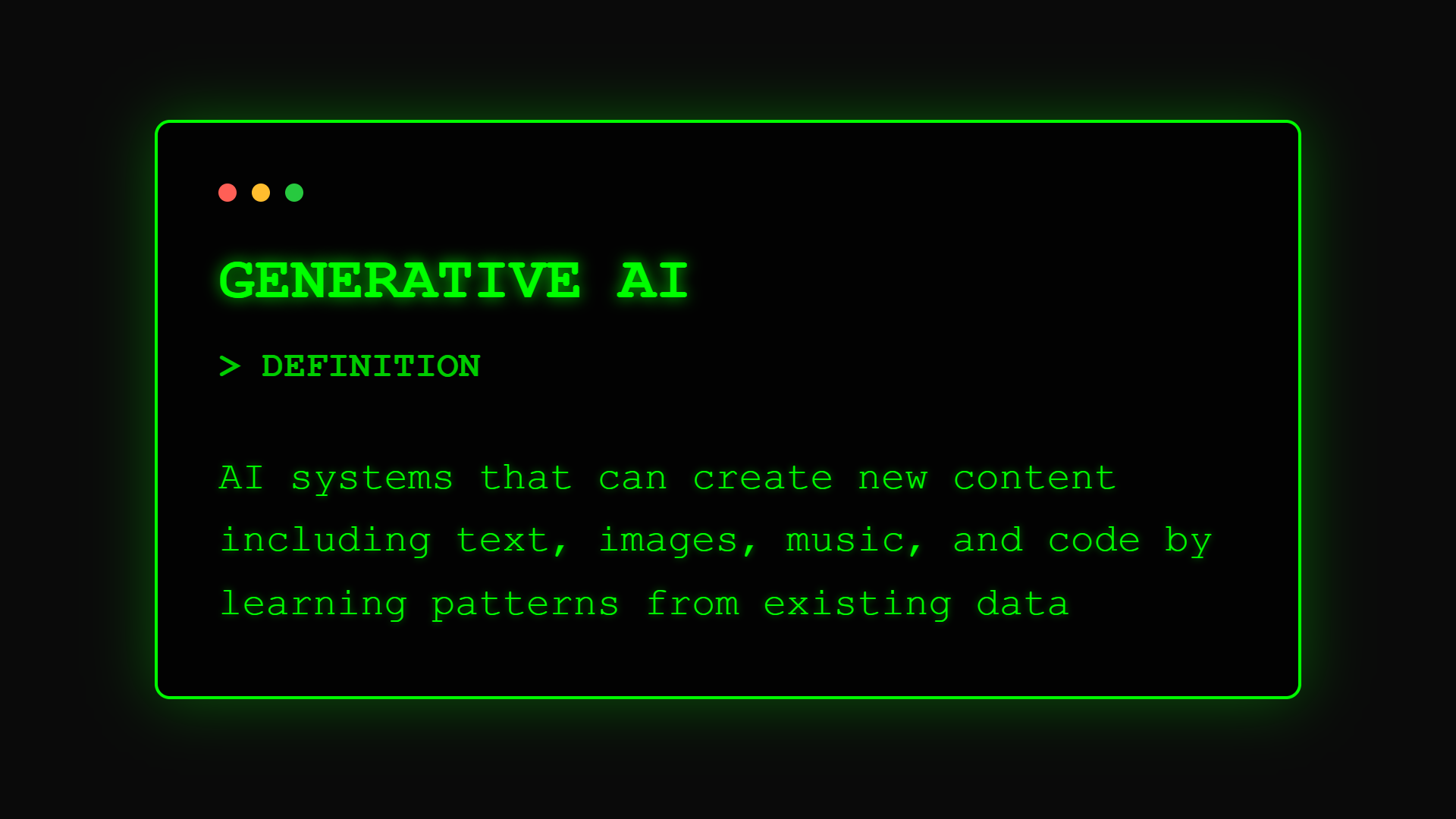AI Terms
What is Generative AI? Your AI Creative Department

What if you had a creative team that never sleeps, generates unlimited ideas, and works at the speed of thought? Generative AI makes this reality, creating original content from marketing copy to product designs on demand. It's not just automation; it's innovation at scale.
The Rise of Creative AI
Generative AI's roots trace to the 1960s with early chatbots like ELIZA, but the modern era began with Ian Goodfellow's 2014 invention of Generative Adversarial Networks (GANs). The field exploded with transformer architectures in 2017.
According to Stanford's AI Index, generative AI is defined as "artificial intelligence capable of generating new content that resembles human-created content, learning patterns from training data to produce novel outputs rather than simply analyzing or categorizing existing information."
The breakthrough came with OpenAI's GPT series and other large language models, which demonstrated that AI could create coherent, contextual, and creative content indistinguishable from human work.
Practical Business Impact
For business leaders, generative AI means having an infinitely scalable creative and knowledge workforce that produces original content (text, images, code, designs) based on simple instructions.
Think of generative AI as a universal creator. Just as a skilled employee can write reports, design graphics, or code solutions, generative AI does all of this simultaneously, learning your style and improving with feedback.
In practical terms, this transforms content production from a bottleneck to a competitive advantage, enabling personalization at scale and rapid experimentation.
Five Core Components
Generative AI consists of these essential elements:
• Foundation Models: Pre-trained neural networks with broad knowledge like GPT for text, DALL-E for images, Codex for code, providing the base intelligence
• Prompt Interface: The instruction system where users describe desired outputs in natural language, the "creative brief" for AI
• Generation Engine: Algorithms that create new content by predicting patterns, combining learned elements in novel ways
• Feedback Mechanism: Systems for refining outputs through iteration, incorporating user preferences and quality standards
• Output Filters: Safety and quality controls ensuring appropriate, accurate, and brand-aligned content
The Generation Process
The generative AI process follows these steps:
Prompt Processing: User provides instructions in natural language like "Write a product description for eco-friendly sneakers targeting millennials"
Pattern Application: AI accesses its training to understand context, style, and requirements, drawing on millions of examples to inform creation
Content Generation: The model produces original output by predicting what should come next, creating unique combinations while maintaining coherence
This isn't copying; it's creating new content based on learned patterns, like how human creators draw inspiration from experience.
Four Generation Categories
Generative AI generally falls into four main categories:
Type 1: Text Generation Best for: Content writing, code generation, translation Key feature: Creates human-like text in any style or format Example: ChatGPT, Claude, marketing copy generators
Type 2: Image Generation Best for: Visual content, design, product mockups Key feature: Creates images from text descriptions Example: DALL-E, Midjourney, Stable Diffusion
Type 3: Audio Generation Best for: Music, voice synthesis, sound effects Key feature: Creates original audio content Example: Voice cloning, music composition AI
Type 4: Video Generation Best for: Marketing videos, training content Key feature: Creates moving images from prompts Example: Runway, Synthesia (emerging technology)
Generative AI at Work
Here's how businesses actually use generative AI:
Marketing Example: Coca-Cola uses generative AI to create personalized ad variations, generating thousands of culturally-relevant campaigns that increased engagement by 35% while reducing creative costs by 80%.
E-commerce Example: Amazon sellers use generative AI to write product descriptions, creating unique content for millions of items that improves SEO rankings and increases conversion rates by 20%.
Software Example: GitHub Copilot helps developers write code 55% faster by generating functions from natural language descriptions, with 40% of code in some projects now AI-generated.
Start Creating
Ready to harness generative AI for your business?
- Understand the foundation with Large Language Models
- Explore Prompt Engineering for better results
- Learn about AI Content Strategy
- Implement with our Generative AI Playbook
FAQ Section
Frequently Asked Questions about Generative AI
Part of the [AI Terms Collection]. Last updated: 2025-01-10